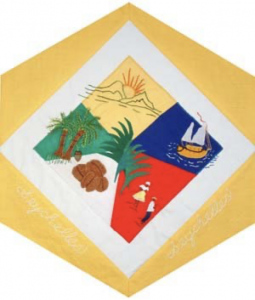Seychelles

The Block
For the Seychelles piece, blockmakers Chantale Dubignon, Elsa Hoarau-Antat and Lita Soleil have combined embroidery and appliquéd techniques. With these they created scenes of daily life on the islands, all set on a partitioned background of national colours. Counter-clockwise from the top, the nation’s tropical climate is reflected in the golden sun rising over the Morne Seychellois, which, at 905 metres, is Seychelles’ highest point. Next are giant coco de mer palm trees, found only on the Seychelles islands and famous not only for the shape of their nut, but also because they can live up to 1000 years. Below them, a collection of their fruit––coco de mer or sea coconuts––sometimes called double coconuts because of their resemblance to two coconuts joined together. These nuts, which take 10 years to mature, are the largest seeds in the plant kingdom. They were once thought to have grown under the sea (hence their name) and believed to possess magical properties. In the next section, lively dancers sway to the rhythmic sounds of the island’s music. Some Seychellois dances, such as the sega zariko and the moutia, were once considered too sensuous and as a result were traditionally performed around a fire under the moonlight. In the final partition, an appliquéd sailboat––a traditional mode of transportation between the islands, as well as the way by which early settlers came to the land––bobs on the calm waters of the ocean. Palm fronds, typically used to weave hats, mats and baskets, are appliquéd in the centre, completing the piece.
Cultural Profile
Seychelles, an archipelago of more than 100 islands, lies in the western part of the Indian Ocean, about 1600 kilometres off the coast of east Africa. The original spelling of its name, Séchelles, was a tribute to the French minister of finance, Jean Moreau de Séchelles; in 1814, under British control, the spelling was changed to the current ‘Seychelles’. The country, which has been independent since 1976, is comprised of two distinct island groups: the southern coral islands and the granite islands of the northern Mahé group. It is believed that the granite islands were once part of Gondwanaland, an ancient continent that disappeared when India split off from southern Africa. Victoria, one of the smallest capital cities in the world, is Seychelles’ only town and its only major port. The islands were uninhabited when the first Europeans arrived in the early 1500s. Approximately 90 percent of Seychelles population, which is predominantly of mixed French and African descent, lives on the main island of Mahé. The official languages are French, English and Créole, a French-based patois. Seychelles is home to spectacular flora, including 80 rare plants and an array of orchids, and a profusion of birds such as the rare Black Parrot, the Magpie Robin and the Paradise Flycatcher and over 3,000 species of insects. The country’s unique culture is a mixture of French and Africa influences, and its friendly inhabitants enjoy a relaxed way of life. The week-long Festival Kreole, attended by Créoles from around the world, is Seychelles’ main cultural event, celebrating Créole cuisine, fashion, art, poetry, and music and dance. The music––a blend of Indian, European, Chinese and Arabic––includes such instruments as accordions, banjos, the makalapo, a stringed instrument, the zez, sitar, African skin drums and the bom. National crafts include woodcarving, coconut shell carvings, and mother-of-pearl jewelery. The Seychellois population in Canada is still quite small. The 2011 census lists just over 1,000 Seychellois.
Sponsor: Ulla Kuhlmann
